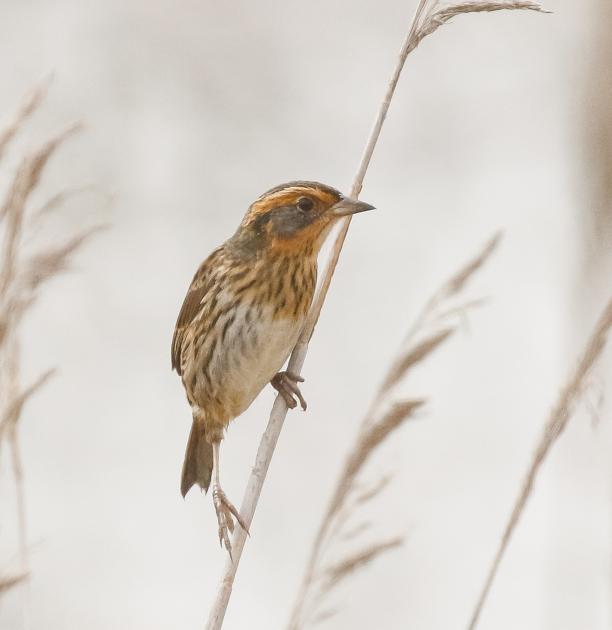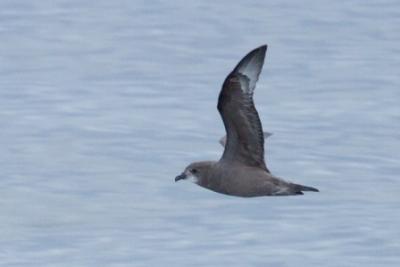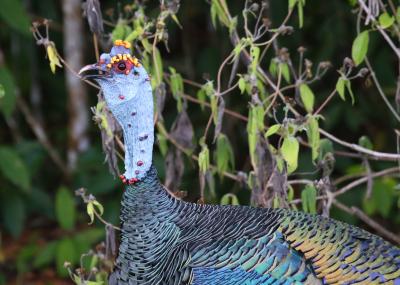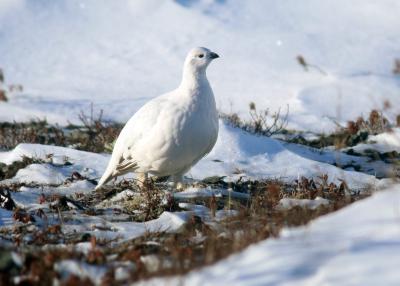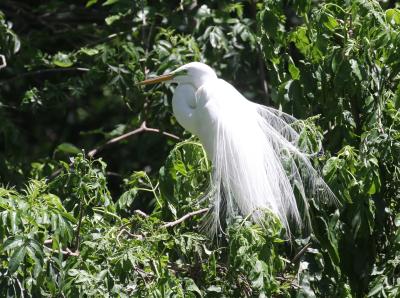New Jersey: Cape May
-
Sep 27 to Oct 3 2025
Skye Haas
2025
Single Room Supplement $800
2025
Single Room Supplement $800
There’s no other way to put it: Cape May is the place to watch the fall migration in eastern North America. At regular intervals, the weather both induces birds to migrate and drives them to the coast, where geography funnels them to the very tip of this narrow sandy peninsula, often followed by impressive numbers of Peregrine Falcons, Merlins, and Sharp-shinned Hawks. Cape May’s marshes, beaches, and mudflats attract sometimes dazzling numbers of egrets and shorebirds, while gulls, terns, and the occasional jaeger or pelican patrol the nearshore waters of the Atlantic.
Apart from our first night in Philadelphia, we’ll be based in a single hotel in Cape May, letting us keep our day-to-day schedule as flexible as possible so that we can take advantage of changing weather conditions—and the unexpected rarities that can show up at any time.
Day 1: The tour begins at 6:00 pm in our Philadelphia airport-area hotel, followed by dinner. Night in Philadelphia.
Cape May with Skye Haas was a great tour. Skye had served for several years at the sea watch, and built up good relationships with the excellent local birders. This really benefited our tour, because he was able to network to find the very best birds and locations each day. Skye is a very pleasant person, good leader, and fantastic birder. He is also a patient and enthusiastic teacher, bringing everyone’s birding up a level. Over 150 species were seen, with care that each member of the group saw every bird. We were also fortunate to hit peak migration and great weather. The warblers and other migrants literally landed all around us in early mornings, and the hawk watch was astonishing. Lastly, the hotel and top restaurants were a pleasure. Thanks for a wonderful time! I highly recommend this tour. - Judi W
Day 2: We’ll leave Philadelphia after an early breakfast for the two-hour drive to Cape May. If the weather seems good for a passerine flight, we’ll drive straight through; otherwise, we’ll make a few stops along the Delaware Bayshore to look for migrants. Once in Cape May, we’ll walk the trails through the weedy fields of Higbee Beach and Hidden Valley to see what may have dropped in overnight. We’ll spend the afternoon at Cape May Point State Park, walking the beach for gulls and terns, checking the ponds for shorebirds—and constantly, obsessively looking up: Bald Eagles are frequent fly-bys this time of year, and up to a dozen species of raptor can occur in numbers. Night in Cape May.
Day 3-4: Even more than the rest of Cape May, Higbee Beach at dawn is charged with all the mystery and excitement of migration. As the sun rises over the ocean, and assuming there has been a good nocturnal migration, the morning flight of Northern Flickers, vireos, warblers, Scarlet Tanagers, and Bobolinks peaks as birds continuing on from night migration encounter the barrier of the Delaware Bay and swing north right over Higbee Beach. The most numerous warblers are likely to be Northern Parula, Black-and-white, and American Redstart, but on a good flight day, more than 20 species are possible, including such uncommon birds as the Connecticut Warbler. Later risers than the falcons and accipiters, Black and Turkey Vultures also spend the night in the area, their lumpy dark forms simultaneously eerie and comical as they crowd the trees.
Each morning will be slightly different and there’s always something new. From Higbee, we’ll drive just down the road to The Nature Conservancy’s South Cape May Meadows. The freshwater ponds and marsh here, protected from the ocean by high dunes, are a great place to watch roosting waterfowl, shorebirds, and terns at close range. We may also bird Cape May Point State Park with its iconic hawk watch platform, an excellent viewpoint to see pond, ocean and sky. In the afternoon we’ll drive north along the Atlantic coast to Stone Harbor, a long barrier island that serves as a regular hang-out for American Oystercatchers, Piping Plovers, Black Skimmers, and roosting terns including Caspian, Common, Forster’s and Royal. The nearby saltmarsh of Nummy Island is famous for the Tricolored and Little Blue Herons that feed daintily in the grassy salt pans. Night in Cape May.
Day 5: We’ll let last night’s weather determine our pre-dawn destination, whether it’s back to Higbee Beach or the Meadows or through the well-treed neighborhoods around the Point. After breakfast, we’ll make the hour’s drive north to the Brigantine unit of Forsythe National Wildlife Refuge. Brig is the best place around to look for godwits, and we should find White-rumped and Western Sandpipers among the thousands of Semipalmated Sandpipers. American Golden-Plover is also a possibility here—as is just about any shorebird ever recorded in eastern North America. Boat-tailed Grackle can be common, and any of the marsh-specialist sparrows is possible along the eight-mile wildlife drive. Night in Cape May.
Day 6: This morning we’ll follow the birds across the mouth of Delaware Bay, taking a large, stable car ferry seventeen miles from Cape May to Lewes, Delaware. Along the way we’ll be on the lookout for Brown Pelicans, Northern Gannets, and Parasitic Jaegers, which regularly harass the flocks of Common and Forster’s Terns feeding offshore. Once in Delaware, we’ll bird Cape Henlopen State Park for Brown-headed Nuthatches and migrants, then move north to Prime Hook National Wildlife Refuge for shorebirds. We’ll have a late lunch, then board the ferry for the return trip to Cape May. Night in Cape May.
Day 7: After a final early morning in Cape May, we’ll return to Philadelphia International Airport where about noon the tour concludes.
Note: The information presented here is an abbreviated version of our formal General Information for Tours to New Jersey. Its purpose is solely to give readers a sense of what might be involved if they take this tour. Although we do our best to make sure that what follows here is completely accurate, it should not be used as a replacement for the formal document which will be sent to all tour registrants, and whose contents supersedes any information contained here.
ENTERING THE UNITED STATES: Non-US citizens will need a valid passport and may need a tourist visa. Consult your nearest US Embassy or consulate for details. All participants must carry some form of photo ID for boarding the Cape May - Lewes ferry.
HEALTH: Birdwatching in New Jersey and Delaware poses no major health hazards. Though their numbers will have decreased greatly by late September, mosquitoes are likely in the more sheltered wooded areas, and biting flies may be present in the saltmarshes. Ticks in this area are known to carry Lyme disease and other potentially serious diseases; precautions are in order.
PACE OF THE TOUR: Early mornings in search of dawn migrants should be expected every day, but some morning starts may be later, depending on overnight weather. Birding will typically end before dark, though we may devote a windless evening to owling. We’ll probably be walking a total of a few miles every day, but always at a slow pace, and the terrain is entirely level.
CLIMATE: Fall weather in southern New Jersey and Delaware is usually pleasant, with mornings in the 50s or 60s F and daytime temperatures rarely higher than the 70s. Breezy, partly cloudy weather is the norm. Those very sensitive to the sun should be prepared with the appropriate hat and effective sunscreen. Rain and wind are possible, so raingear is highly recommended.
ACCOMMODATION: Standard motels throughout.
DRESS: Informal throughout.
TRANSPORT: Travel will be in a fifteen-passenger window van driven by the leader.
SMOKING: We request that you not smoke in vehicles or when the group is gathered for meals, checklist sessions, etc. If you are sharing a room with a non-smoker, please do not smoke in the room.
GENERAL INFORMATION AND CONDITIONS OF WINGS TOURS: Please take a moment to read the General Information and Conditions. This section contains important information about how we conduct tours, e.g., what is included in the tour price, refund and cancellation policies, pace of the tours, and other information that will help you prepare for the tour. If you don’t have access to the WINGS website, please ask the WINGS office to send you a copy.
ADDITIONAL INFORMATION: A more complete General Information for Tours to New Jersey and Delaware will be sent to each registrant on receipt of booking. Final information with instructions for meeting the group, hotel addresses, etc., will be mailed about three weeks before trip departure. Other news will be communicated as necessary. If you have any questions, please let us know.
2024 Narrative
In Brief: The capital city of bird-watching, Cape May, set at the southernmost tip of New Jersey, is renowned for its epic migrations, as well as the rich birding community that has grown up here over the years. Conditions were a little challenging in some regards, a prolonged north-easterly blow didn’t allow for any major migratory movements, but our species count of 148 came in right about on our annual average for this tour. The easterlies made for some good looks at a few seabirds such as flocks of Black Scoters and a few Parasitic Jaegers! We ended up with a nice selection of songbirds observed, with Alder Flycatcher, Philadelphia Vireos, and Blue Grosbeak among the highlights and 18 species of warbler including Prairie, Black-throated Blue and Ovenbird.
What was notable about this week was the incredibly high water levels due to the storm surge which made for some great shorebirding as birds ended up having large concentrations in just a few locales that made for some excellent studies! We saw 20 species of shorebird, many of which gave us cracking good looks! Another byproduct of the flooded salt marshes was some in our face looks at the normally skulky Saltmarsh Sparrow--our afternoon with them becoming a favorite memory from the trip for some! The high waters also allowed our salt marsh boat tour to really get into some of the back bays, and I’ve never had as many Clapper Rails on this tour as we did this year, as well as point-blank looks at a Great Cormorant!
In Detail: Our merry band of adventurers came together in Philadelphia, where we had dinner at our hotel’s bistro and got to know one another. I wove tales of the history and going-ons of Cape May, the Bird Observatory and the birding culture that had grown up around this legendary locale. We headed out the next morning in our swanky tour van, ( I do love a van that allows people to easily move around in!), and cruised on over to the south Jersey shores. We stopped first at the site of the Avalon Seawatch. Though the count season for this site was still a few days away from its start, having been the former Avalon counter for a couple of seasons, I always like to swing by here to see what's flying. A handful of Royal and Caspian Terns provided our first lesson in similar species identification. A very distant Cory’s Shearwater remained elusive and only a couple people managed even a glimpse of this bird before it drifted off in the waves. We then bopped over to a heron roost where we got in another ID study; this time between Yellow-crowned and Black-crowned Night Herons. Yellow-crowneds tend to slip away this time of year, so I always hold my breath if we are going to see them or not. We continued down the inner salt marshes to the Wetland Institute, which turned out to be a nice stop with a large flock of Western Willets, multiple Little Blue and Tricolored Herons out in the marsh, and a couple of American Redstarts and Northern Parulas dancing about in the trees by the parking lot.
We then headed down to Cape May proper, first stopping at a small market to pick up some fantastic sandwiches to take with us to the state park where the Cape May Bird Observatory (CMBO) runs its hawk watch. Upon our arrival, it was hard to make the time to get those delicious sandwiches down before picking up our binoculars! The trees surrounding the picnic tables were full of songbirds and as soon as we could, we slid right into our afternoon birding. Both Red-eyed and White-eyed Vireos were present, the latter being the only one we would record for the trip. And a sprite-like flock of warblers vigorously foraged in the cedars, and we had numerous looks at Parula, Cape Mays, a handsome Black-throated Blue, Yellow and even a Prairie Warbler! It wasn’t a big day for hawks, but a steady trickle of Cooper’s Hawks, Northern Harriers and Merlins gave everyone an introduction to the birthplace of modern day hawk-watching.
We then checked in to our modest seaside hotel and took a little break, and afterwards we headed over to CMBO’s visitor center to get another serving of warblers to end the day on. The native plant gardens on the grounds combined with the late afternoon sun often makes for good songbird forage here and we had excellent looks at some new species like Black-and-white, Blackpoll, and Chestnut-sided Warblers, as well as Brown Creeper, Red-breasted Nuthatch, Ruby-throated Hummingbird and great views of a Philadelphia Vireo! We went straight to dinner at an excellent Italian restaurant near our hotel and then fell into bed- not bad for a first day!
On this tour, most mornings at Cape May begin with breakfast at a pancake house just up the road from our hotel. Tasty and quick, and even more appealing is the large flock of Black Skimmers that like to hang out on the beach just across the street from the restaurant! We then headed down to the Cape May Marina to take a tour of the back water bays and salt marshes for the rest of the morning. Using a flat-bottomed boat, we could access some shallow reedy areas to look for birds, though nothing about today’s ride was going to be shallow! The weather had been a strong northeasterly for days, and that coupled with a full moon tide had made for some truly epic high water levels that would have some positive and negative effects on our day’s birding. Some of the flats that we were hoping to see shorebirds on were completely under water. But we did end up seeing a fair amount of shorebirds crowded up on breakwalls and floating detritus. Flocks of American Oystercatchers, Ruddy Turnstones and Semipalmated Sandpipers all huddled together on promontories above the water waiting patiently for low tide.
A real treat was a trio of Eastern Willets, the local breeding subspecies that is typically gone from North America by this time of year. Floating reed mats also made great perches for numerous Clapper Rails to escape the high tides, and we broke our tour record for this species, recording 14! Lots of terns were observed roosting, mostly Royal and Forster’s, but a small flock of Common Terns were out on a breakwall, the only ones we would see on this tour. On the same breakwall, we had a fantastic look—perhaps one of my best ever—of a juvenile Great Cormorant, always a real prize for this tour. We ended our boat ride and took a break for lunch at a restaurant, and then headed back out for more shorebirding in the afternoon.
With the high tides still raging, we ended up having some fantastic looks at shorebirds right at our feet, with flocks of Sanderlings, Western Sandpipers and Semipalmated Plovers scurrying around, all furiously foraging. Large flocks of American Oystercatchers were roosting on sandbars and within them a Marbled Godwit made for a nice get, while a pair of Whimbrel flying over would be the only ones we would see during our week. We finished up with what was becoming our evening routine of birding the grounds of the CMBO Northwoods Center for songbirds, a nice “come-down” from the day’s hustle. Not too many warblers were present tonight, but a pair of Veerys and a Rose-breasted Grosbeak certainly made the stop worth our time!
We started our birding the next day at the Coral Deck. This is the southernmost tip of Cape May and makes for an excellent place to see a diversity of both land and waterbirds. Looking out over the ocean we saw a flock of Black Scoters, another Great Cormorant, and multiple Lesser Black-backed Gulls. Meanwhile on the pine-clad dune ridge where we stood, many passerines streamed by on their morning flight passage: Blue-gray Gnatcatchers, Bobolink, Northern Waterthrush, Nashville, Palm and Blackpoll Warblers. A real treat was a flock of Field Sparrows foraging right next to the observation deck. For our afternoon birding, we headed up to Forsythe National Wildlife Refuge. Birding the refuge is always a delight; it features a lengthy auto loop with plenty of opportunities to get out and bird along the way. Being composed of mostly a large marsh, waterbirds are our primary focus here, though hunting raptors like Northern Harriers and Peregrine Falcons do give some great looks. Flocks of ducks are starting to gather, and we see numerous Northern Shovelers, Blue-wing and Green-winged Teal, along with a few Wood Ducks, Black Ducks and Northern Pintail. Shorebirds are present too, big flocks of Black-bellied Plovers and Greater Yellowlegs, but we also get a few new species for the tour, Dunlin and White-rumped Sandpiper. Snowy and Great Egrets were everywhere, and a recent colonizer to New Jersey is the White Ibis, of which we tally in nearly 300 that afternoon! But everyone’s favorite sighting was the excellent views we had of the flock of Saltmarsh Sparrows, pushed up to the sides of the road by the high tides. Magnificent views of a sublime bird!
We returned to the Coral Deck the next morning for another combo seawatch/morning flight. It wasn’t quite as active as the day before but we had our first Tennessee Warbler of the trip, and out on the water, multiple Parasitic Jaegers were harassing the gulls and we all ended up getting some decent looks at this enigmatic seabird, which is not easy to do! Another cool seabird was a flyby Northern Gannet, the first one I’ve had on this tour in a few years. We then took a walk at the Cape May Meadows, a preserve managed by The Nature Conservancy. Songbirds were clearly just not in today, though we all enjoyed a handsome Eastern Towhee that teed up in the wax myrtle along the dunes. But what ended up being a bit of a surprise was some quality shorebirds in a small semi-freshwater pond where we had in-our-face looks at Lesser Yellowlegs, Stilt Sandpipers and the real shocker of a Red Knot! And for our evening birding at the Northwoods Center, we had some great timing and pulled up right as a rain shower had ended so bird activity was popping off with some great looks at Ovenbird, Black-throated Blue Warbler, Myrtle Warbler and Yellow-bellied Sapsucker.
For our final full day of birding, we had quite the adventure planned! We were getting up early and taking the car ferry across the bay into Delaware! Leaving shortly after sunrise, accompanied by a cloud of Laughing Gulls we chugged out into the Delaware Bay. We diligently scanned for seabirds, but the morning was foggy and not too much was flying. Still we ended up having a few Northern Gannets passing us by - a real thrill to see such wild looking seabirds! As we came into the harbor in Delaware, the outer breakwalls were coated in hundreds of Great Black-backed Gulls and Brown Pelicans.
We then headed into Cape Henlopen State Park, a delightful pine forest set on old dune ridges. Here we were looking for one of the northernmost populations of Brown-headed Nuthatch. Sometimes, these cute little buggers take forever to track down in the pineywoods, but today, we walked right up to them in a mixed flock of birds that included Carolina Chickadees, Tufted Titmice and Eastern Bluebird. We would go on to encounter several flocks of these squeaky-voiced nuthatches over the course of our day, truly one of my best days for this species ever on our Cape May tours!
We then headed over to a large marsh to make an attempt for a vagrant Roseate Spoonbill. Sadly we did not find the bird, apparently it had been present for a few days, but must have departed the previous evening as no birders ever reported it again, but it was a pleasant enough walk that yielded a Green Heron and more Nuthatches. We then got a report that an even rarer bird had been reported down on the beach nearby, a Common Ringed Plover from Europe! There had been a little influx of them to North America in the last few days so this sounded promising and we were close by so we decided to try to track the bird down. It took a bit of a beach hike to relocate, but when we did, things seemed off for the bird, and more in line for the expected look-alike species Semipalmated Plover. After a long careful study of the bird and our photographs, it was eventually inescapable of a conclusion, the initial ID had been mistaken. Still I always enjoy a good ID puzzle and embrace a learning experience when it comes to birds! For our return trip back across the Delaware Bay, we kept an eye to the water and had a Parasitic Jaeger go by as well as a great look at a Bonaparte’s Gull.
We finished up the tour the next morning with a little more birding around Cape May visiting a couple of our favorite spots. The Coral Deck had a large flock of Black Scoters floating offshore, and a few Cape May Warblers flitting about the pines to say farewell. And we stopped by Northwoods Center on the way out where we picked up two last species- a Black-throated Green Warbler and an Alder Flycatcher, my first ever for this tour! Always a great way to finish a tour by picking up a new species for the all-time tour list.
- Skye Haas
Skye is a very pleasant person, good leader, and fantastic birder. He is also a patient and enthusiastic teacher, bringing everyone's birding up a level.
- Judith W. on New Jersey: Cape May
Skye was the best tour leader I could hope to have. I am a beginning birder and we had a variety of knowledge among the tour members. Skye did a superb job of adjusting to our various needs for information, to adjusting as needed to make sure each of us could see the birds, to adjusting on the fly when new info came in about where the birds were, or the best areas to bird at a given moment. His extensive knowledge of so many individual birds and their details: male and female coloring, their songs, their flight patterns, where they should be or not be and he has an excellent ability to convey the info to us.
- Kathy K. on New Jersey: Cape May
Cape May with Skye Haas was a great tour. Skye had served for several years at the sea watch, and built up good relationships with the excellent local birders. This really benefited our tour, because he was able to network to find the very best birds and locations each day. Skye is a very pleasant person, good leader, and fantastic birder. He is also a patient and enthusiastic teacher, bringing everyone’s birding up a level. Over 150 species were seen, with care that each member of the group saw every bird. We were also fortunate to hit peak migration and great weather. The warblers and other migrants literally landed all around us in early mornings, and the hawk watch was astonishing. Lastly, the hotel and top restaurants were a pleasure. Thanks for a wonderful time! I highly recommend this tour.
- Judi W. on New Jersey: Cape May
You all did a great job. Thanks, Erin. Skye was great. Truly a joy to be around. He showed incredible patience, willingness to teach, great improvisation with tougher conditions this year (persistent East Wind), all of which made it a great trip. Thanks, Skye. Hotel was basic but plenty good. Dinner spots were well thought out and excellent. The van was excellent. All in all, a really nice trip made as best as possible despite some slower than normal bird activity.
- Craig D. on New Jersey: Cape May
Maximum group size seven with one leader.





















































